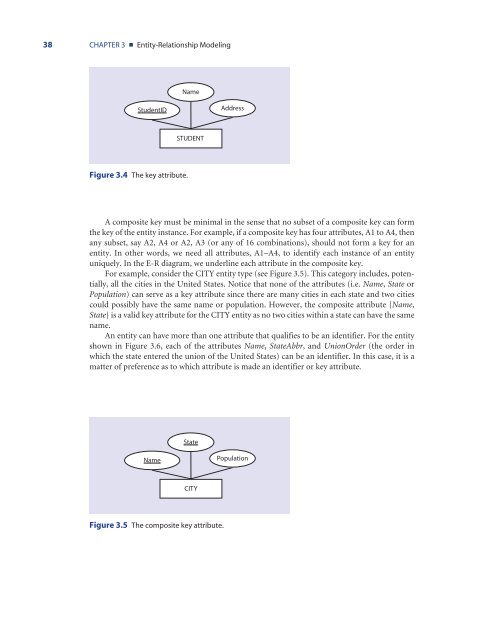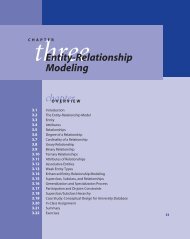Web-DSS-Chapter-03
Web-DSS-Chapter-03
Web-DSS-Chapter-03
Create successful ePaper yourself
Turn your PDF publications into a flip-book with our unique Google optimized e-Paper software.
38 CHAPTER 3 ■ Entity-Relationship Modeling<br />
Name<br />
StudentID<br />
Address<br />
STUDENT<br />
Figure 3.4 The key attribute.<br />
A composite key must be minimal in the sense that no subset of a composite key can form<br />
the key of the entity instance. For example, if a composite key has four attributes, A1 to A4, then<br />
any subset, say A2, A4 or A2, A3 (or any of 16 combinations), should not form a key for an<br />
entity. In other words, we need all attributes, A1–A4, to identify each instance of an entity<br />
uniquely. In the E-R diagram, we underline each attribute in the composite key.<br />
For example, consider the CITY entity type (see Figure 3.5). This category includes, potentially,<br />
all the cities in the United States. Notice that none of the attributes (i.e. Name, State or<br />
Population) can serve as a key attribute since there are many cities in each state and two cities<br />
could possibly have the same name or population. However, the composite attribute {Name,<br />
State} is a valid key attribute for the CITY entity as no two cities within a state can have the same<br />
name.<br />
An entity can have more than one attribute that qualifies to be an identifier. For the entity<br />
shown in Figure 3.6, each of the attributes Name, StateAbbr, and UnionOrder (the order in<br />
which the state entered the union of the United States) can be an identifier. In this case, it is a<br />
matter of preference as to which attribute is made an identifier or key attribute.<br />
State<br />
Name<br />
Population<br />
CITY<br />
Figure 3.5 The composite key attribute.



